American Spitfire Pilot in 1944 and 2005
You all know by now how much I love Spitfires. My list of Five Facts I Never Knew about Spitfires needs expanding: I never knew that a Spitfire could make it from Oxford to Berlin and back. I realised that the short-range aircraft must have had special fuel tanks for these reconnaissance flights and started to look into it. To be honest, the whole story is pretty amazing. Let me start again…
During the Second World War, the US Airforce planned for their fighter units to fly the Bell P-39 Airacobra, but it quickly became clear that the P-39 lacked the manoeuvrability to fight against modern Japanese and German aircraft. The Spitfire provided the alternative.
Uncle Sam’s Spitfires — Articles | 1942 | 1943 | 1944 | history | Spitfire Mk. V | Spitfire Mk. VIII
The first P-39 unit to arrive in England was the 31st Fighter Group – the first unit to have taken the Airacobra operational the previous year – though they arrived before their aircraft. In the interim, they were equipped with the Spitfire Mk. V. By the time the similarly-equipped 52nd Fighter Group arrived, the RAF had been able to convince the Americans of the unsuitability of the P-39 for aerial combat in western Europe. As a result, both groups were equipped with Spitfire Mk. Vs.
Uncle Sam’s Spitfires had written a little-known chapter in US fighter history. Though the USAAF used over 600 Spitfires during the war, the aircraft was never given a US designation, and little publicity was given to the exploits of the 31st and 52nd Fighter Groups – nothing like what they would get in the summer of 1944 during the wild air battles over Ploesti when they flew Mustangs. This is most likely a good example of the US military’s overall dislike of having to admit to using “NIH” (Not Invented Here) equipment.
Thus, the Spitfire became one of very few foreign aircraft used within the US Airforce. Spitfires were also used by the US Navy after the Normandy landings.
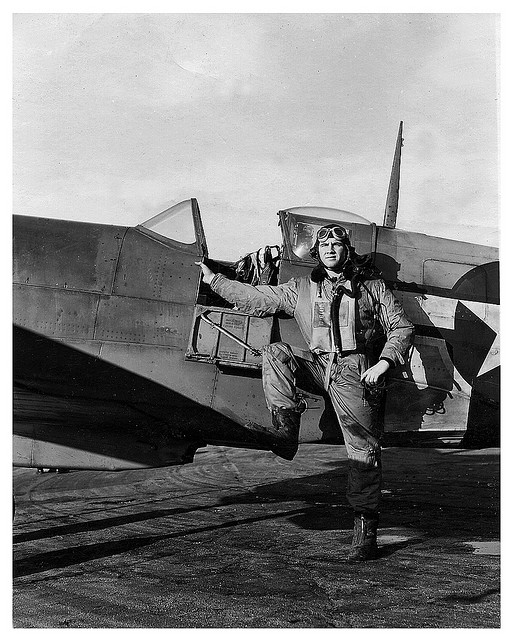
One of the American pilots flying the Spitfires in England was Lieutenant Colonel John Blyth. Blyth joined the Oregon National Guard in 1938 when he was 15. His son, Scott Blyth, was kind enough to tell me about his background. Scott’s comments are in the photo captions and the blockquotes.
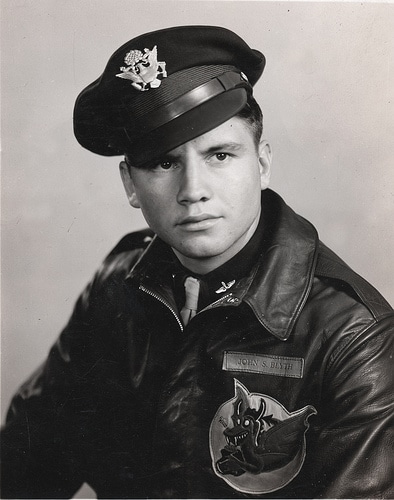
My father signed up for the Flying Sergeants program which allowed men with only a high school education to become pilots.
They were known as the Flying Sergeants because they received the rank of staff sergeant when they graduated from flight training. For most, it was a once-in-a-lifetime chance to fly. But pilot training was tough. According to Lee Arbon who wrote They Also Flew, half the candidates were cut after the medical physical and only a quarter made it out of training.
Lieutenant Colonel Blyth made it.
He trained on twin engine aircraft and went through all the phases of pilot training beginning in California and finishing up at Petersen Field in Colorado Springs. They flew F-4s which was the photo recon variant of the P-38 Lightning. He was promoted from Flight Officer to Lieutenant before shipping out for England in 1943.
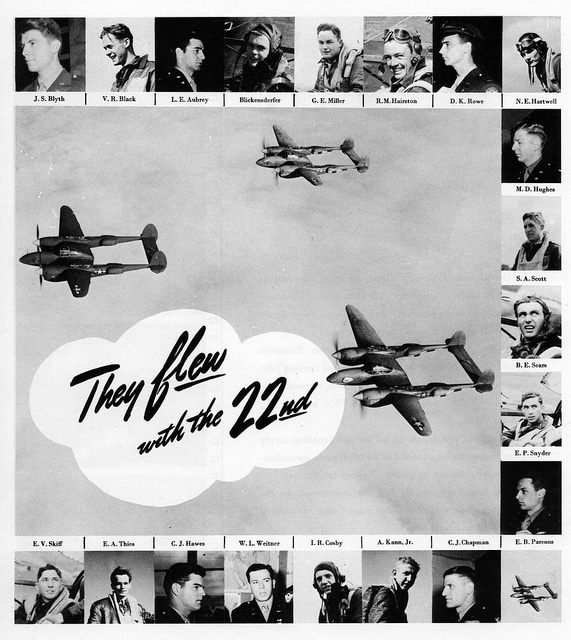
He was based with the 22nd Squadron of the 7th Photo Group at Mount Farm, Oxfordshire, UK. He flew about 15 missions in F-5s which was also a variant of the P-38.
Blyth wasn’t fond of the F-5s. He’d wanted to fly a Spitfire since he saw photographs of them as a teenager after the Battle of Britain, so when he heard about Spitfires on loan to the US Air Force, he immediately tried to find out more. When the Spitfire MK XIs arrived at Mount Farm a few weeks later, Blyth passed on the opportunity to be promoted to Captain and instead requested a transfer to the 14th Squadron.
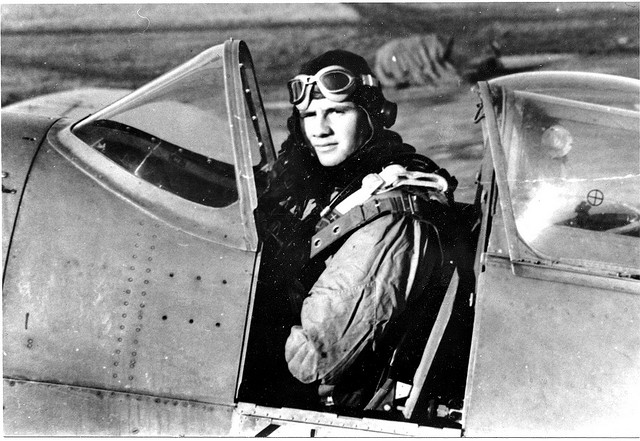
He flew thirty-six reconnaissance missions in the Spitfire and reached the rank of lieutenant colonel.
The photo reconnaissance planes had no guns and the missions were flown without an escort. Instead of weapons, the Spitfire Mark XI had leading edge gas tanks for a longer range, which allowed the pilots to take the plane as far as Berlin to take photographs of the enemy targets. They had cameras mounted on the back. The planes were painted sky blue to help them “blend in” but it didn’t seem to do much good. Colonel Blyth said he regularly came under fire and all he could do was keep flying and try to ignore it.

On the 12th of September in 1944, Blyth, who by now had risen in the ranks to Captain, got into trouble while on a reconnaissance mission in Germany. His headset cord got caught in the manual system for the landing gear and the landing gear got locked up. He flew around trying to get the wheels down and failed. In the end, Blyth was forced to make a belly landing in the Spitfire Mk XI PA 944.
It was a day he’d never forget.
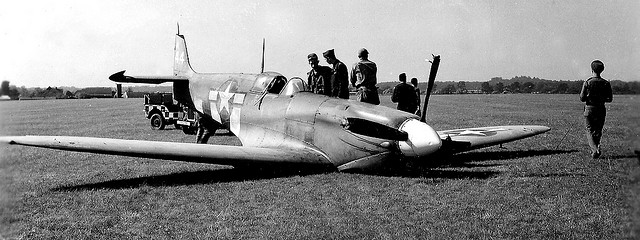
For many years my father had told us of how Doc Savage had taken moving footage of the belly landing. We figured we would never see it as Savage was probably dead and the footage was lost forever.
John “Doc” Savage, was based at RAF Mount Farm with Lieutenant Colonel Blyth. He filmed an amazing amount of footage at the base on his 16mm camera, documenting his World War II experience. In 2005 after his death, his descendents restored and digitised the film to make sure that it was preserved. Wouldn’t it be great, they thought, if they could find the men in the World War II footage and show it to them? In the process, they found a clip of a Spitfire doing a belly landing at RAF Mount Farm and began to search for the pilot.
William Lorton I believe sent a letter to every John Blyth in America who could potentially have been the pilot. My father responded to the letter. Lorton and his crew showed up at my parent’s home in Washington State. The intent was to surprise him with the footage of his wheels up landing and they succeeded.
They knew he’d probably never seen the footage. They asked if he would help them with a documentary they were working on and that they had footage from the war that they wanted to show him. Lieutenant Colonel Blyth was 83 years old when they went to see him.
The following 15-minute video is the amazing result of that visit, when Lieutenant Colonel Blyth sees the footage of his landing for the first time and talks about his photo-reconnaissance flights from Oxford to Berlin and back in the Spitfire Mk XI. The stories of Doc Savage and Lieutenant Colonel Blyth make for compelling viewing:
The mini-documentary Spitfire 944 is also available in HD on iTunes.








This was absolutely incredible great bravery what a life to have led and what a great conclusion Well done
sir; saw the google version of john c. blyth & his spectacular belly landing of PA 944.would very much like to ask one or two questions about the mk 11. is this possible ? ahai, a very fine film . regards , wn.
Great men It took a special man to fly an unarmed plane into harms way.
We owe these pilots a debt that we can never repay
Brave pilots flying unarmed and so young too. Is there any lasting memorial to these pilots if not there should be
There are but somehow it never seems enough.
Great story one plane i would really love to fly. Can anyone tell me is John Blyth still living ????.
Great man, great men
Great video and story. I served in Hq TAC when Gen Dixon was COMTAC. I didn’t know at that time he had been a Spitfire pilot nor that he had been a POW. Thanks to the video producers and to John S. Blyth for this movie/video and for giving me a clue about the guy named Dixon who later became a four-star General. Jim Bradley
This guy was my mother’s neighbor in Washington..they used to walk down to the beach together and hed tell war storries sadly he died recently ..
Last summer I got to fly the Goodwood Spitfire,from the backseat of course. After take off it was mine for about a half hour or so. Before landing I was treated to some aerobatics. I had dreamed of flying a Spitfire since I was a boy growing up during WWII.
Many years ago I built ,with a tremendous amount of help, a 3/4 scale Spit. It took 14 years from start to finish. It was an incredible flying machine easy to fly very responsive. Landings were a bit of a thrill at times.
She is now in The Minnesota Air National was Guard Museum, located on Minneapolis/St. Paul Airport.
That’s fantastic!
A small town in France, this summer, is honoring 3 pilots shot down 1/27/1944. They were members of the 4th Fighter Squadron, 52nd Group US Army flying Spitfires. Lt. Lyle R. Kater, Lt. Harold Beedle and Lt. Ottaway Cornwell. Does anyone have any pictures of the 4th or in particular these pilots or of this unit? Any information will be much appreciated.
Looking for WW II combat pilots, who flew missions in either the European or Asian theaters, to be our guest speaker at our 10th annual Aviators dinner, in Delray Beach FL. We will cover travel and lodging expenses.
We are looking for an American Spitfire pilot to be our guest when we screen the Spitfire documentary for a local Flying Association.
These pilots, like John S Blyth, were truly part of the Greatest Generation; they had balls of steel to fly the missions they did. Especially John in that he flew alone with no protection of any kind including no guns, etc.
Thank you to all of you who serviced in the US Military.
LT COL JOHN S BLYTH USAF Was my Dads friend and Commander in the USAF At Mc Chord field he was also our insurance agent LOL He knew me as a kid and I was also in Awe of him and all the men that visited our house in Spanaway Washington Had a great talk with him after my father SMS JAMES H FARLAND Passed away in 2008 He told me that my Dad his Line Chief in the 318th was the best mechanic that ever served under him kind words from a great man He sent me a copy of Spitfire 944 and I am honored by his kind words of my father GODSPEED JOHN